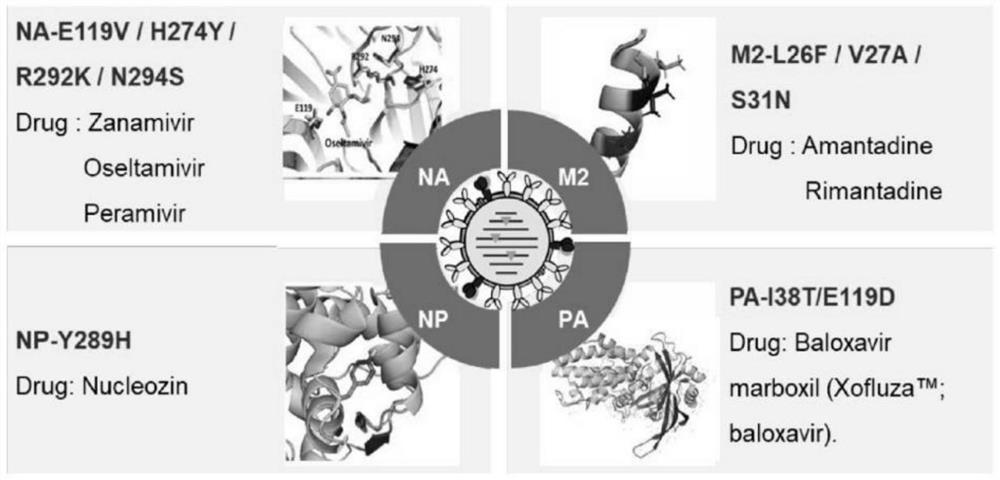Replication-defective drug-resistant influenza virus and nucleic acid segment recombination rate detection method thereof
A replication-deficient, influenza virus technology, applied in the field of biopharmaceuticals, can solve the problems of poor effect, lack of abundance, non-replicating influenza virus stimulating immune response for a long time, etc.
- Summary
- Abstract
- Description
- Claims
- Application Information
AI Technical Summary
Problems solved by technology
Method used
Image
Examples
Embodiment 1 12
[0082] Example 1. Construction of 12 Drug-resistant Influenza Virus Strains and Evaluation of Packaging Efficiency
[0083] 1.1 According to the mutation site analysis of different types of drug resistance of different influenza viruses and the types of small molecule drug inhibitors (such as figure 1 Shown), through gene mutation and molecular cloning methods to construct drug-resistant influenza virus strains.
[0084] First, carry out point mutations of the drug-resistant sites of the NP, PA, and NA segment plasmids, and then combine different drug-resistant mutation sites in the NA segments. The specific drug-resistant mutation sites and point mutation primers of different segments are listed in Table 1. Show.
[0085] Table 1. Point mutation primers for drug-resistant mutation sites in different segments of influenza virus
[0086]
[0087] The sequences of point mutation primers for drug-resistant mutation sites in different segments of influenza virus in Table 1 ar...
Embodiment 2
[0093] Embodiment two, systematic evaluation 12 kinds of drug-resistant influenza virus strain drug resistance rates
[0094] The drug resistance rate is evaluated by IC50 value, IC50 is the half-inhibition rate, and the standard curve is S-shaped. It refers to the drug concentration corresponding to when the amount of virus in the drug-dosed group is half that of the control sample. The higher the IC50 inhibition, the worse the sensitivity of the influenza virus to the drug. Different drug resistance mutations (take A / WSN / 33(H1N1) as an example) correspond to different drugs with decreased sensitivity.
[0095] The determination method is as follows:
[0096] 2.1 Cell preparation: Take out MDCK cells from the incubator, and observe the cell state and confluence under a microscope. Digest the cells when they are approximately 90% confluent. After aspirating the cell culture medium, add 2mL PBS buffer to wash once, add 1mL 0.25% Trypsin-EDTA, put it in the incubator and let ...
Embodiment 3
[0102] Example 3. Real-time visual labeling of five different proteins of influenza virus
[0103]Through the transpeptidase reaction, using the enzymatic reaction polypeptide fixed-point labeling technology, by inserting small short peptide sequences into the viral genome, using the corresponding enzymes to specifically recognize short peptide sequences and dyes, without affecting the growth kinetics of the virus Under the premise, fluorescent labeling of different proteins of influenza virus is realized. 5 proteins of influenza virus were labeled by 3 kinds of protein site-specific labeling techniques. The labeled influenza virus can be used to monitor the life activity of the virus after entering the cell. Specifically insert the corresponding peptide sequence on five different plasmid fragments of NA, HA, M1, M2, NP, NA-ybbR / M2-ybbR, NP-FlAsH / M1-FlAsH, HA 5Xgly .
[0104] The double arsenic-tetracysteine labeling technique is used to realize the specific labeling of t...
PUM
 Login to View More
Login to View More Abstract
Description
Claims
Application Information
 Login to View More
Login to View More - R&D
- Intellectual Property
- Life Sciences
- Materials
- Tech Scout
- Unparalleled Data Quality
- Higher Quality Content
- 60% Fewer Hallucinations
Browse by: Latest US Patents, China's latest patents, Technical Efficacy Thesaurus, Application Domain, Technology Topic, Popular Technical Reports.
© 2025 PatSnap. All rights reserved.Legal|Privacy policy|Modern Slavery Act Transparency Statement|Sitemap|About US| Contact US: help@patsnap.com



